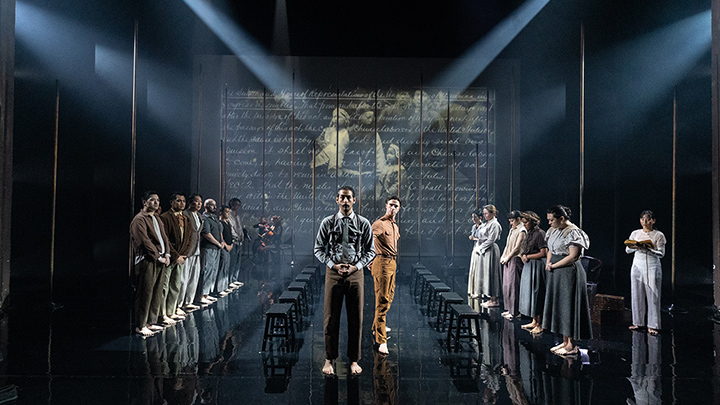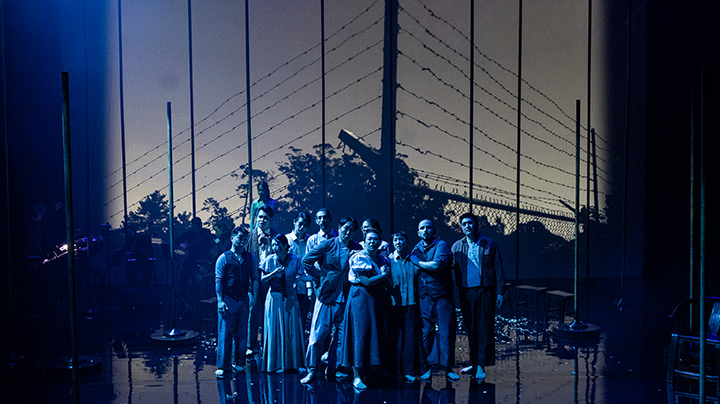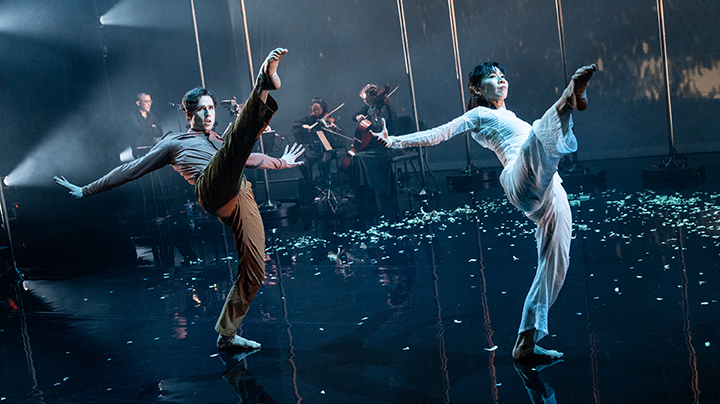
Huang Ruo’s Angel Island, part of this year’s Prototype Festival and currently playing at Brooklyn Academy of Music, is a multimedia, multi-genre experience, standing somewhere at the junction of song cycle, opera, dance piece, and documentary theater. Despite Ruo’s moving and challenging compositions, Angel Island’s multiple tones and forms never quite coalesced into a single piece. Instead, its darkly beautiful choral settings and documentary-style interludes came together without effectively reconciling the emotional and the educational.
Structured as a series of alternating choral pieces and narrated interludes, Angel Island comprised two conceptual throughlines. In one, Ruo set to music poems written by Asian detainees on Angel Island, an immigration center in San Francisco Bay. For decades, Angel Island processed, incarcerated, and deported Chinese migrants, whose presence in the United States was harshly curtailed by the Chinese Exclusion Act of 1882. In the other, voiceovers narrated dark chapters from the 19th and 20th century histories of Asian immigrants in the United States.
Angel Island’s emotional core is certainly its four choral pieces, settings of the poetry that incarcerated Asian immigrants carved into the walls of Angel Island’s detention centers. These poems, written in classical Chinese, are remarkable artistic artifacts, inscribing the melancholy, loss, isolation, and hopelessness of imprisoned migrants directly onto the walls of their captivity. Imagery of the island itself recurs in them—its solitude, its harsh terrain, and, particularly, the sea that encircles it, separating the poets both from their home lands and from America, geographically near but seemingly forever out of reach.
Sung by a chorus of twelve singers and accompanied by the Del Sol Quartet, Ruo’s settings brought this text vividly to life. Pulsing and densely textured, Ruo’s vocal lines washed over one another like the relentless lapping of the San Francisco Bay against the island’s shores, aligned into tone-clustered columns of defiant sound, broke into sobs, and tolled sorrowfully like mourning bells.
The singers, mostly hailing from the Choir of Trinity Wall Street, handled both the challenging vocal lines and the Chinese text with confidence. Classical Chinese poetry can be fairly oblique, economical in text but expansive and ambiguous in meaning and symbolism. Ruo’s music felt as though it animated not only the concise text of the poems but also the complex sweeps of emotional affect contained within them. His compositions struck me as close readings of the poems as much as settings, working through music to translate and interpret the poems’ many meanings.
Ruo’s choral compositions were moving, hypnotic, and challenging—it’s understandable to me that he and director Matthew Ozawa would want to break them up with other material rather than present them in sequence. Unfortunately, the historical interludes that alternated with the choral pieces never quite worked theatrically.
These sequences resembled mashups between documentary film and modern dance. The choreography, by Rena Butler, featured two dancers, Benjamin Freemantle and Jie-Hung Connie Shiau, who gave high-energy, vivid performances, particularly Schiau. It also featured the chorus, who were very committed, but at times a little awkward in their movements, as choruses doing choreography often are.
Behind and around these dance sequences was material that seemed pulled directly from a TV documentary on the history of anti-Asian racism in America. In voiceovers, actors Wai Ching Ho and Marc Kudisch narrated a series of historical events, from a Los Angeles race riot in 1871 that left eighteen Chinese immigrants murdered, to the Page Act of 1875 that banned Chinese women from America on the grounds that they must all be sex workers, to the story of Chinese migrants who survived the sinking of the Titanic only to be incarcerated in New York City and deported. Bill Morrison’s video projections during these sequences would not have been out of place in a Ken Burns documentary, prominently featuring slow camera pans over historical documents.
Despite the performers’ best efforts to bring movement and visual interest into these segments, the tone of the interludes was unavoidably educational—reminiscent of the kinds of informative short films that one might encounter as a visitor to a historical site such as Angel Island. While perhaps intended to contextualize the poetry by describing some of the brutalities experienced by their authors, the dry, documentary style narratives never truly connected to the pathos and subtlety of the choral pieces, particularly as they relegated Ruo’s music to a backing score played by the Del Sol Quartet.
In fact, the documentary segments did not seem to be particularly connected even to one another. In the Titanic segment, for example, the text mentioned the Chinese Exclusion Act, and then explained what it was, as if the audience were encountering it for the first time. In fact, the Page Act segment had already extensively described the Chinese Exclusion Act. Moments like these made these historical interludes feel even more disconnected from any potential throughline shared by the piece as a whole—an unfortunate feeling, since I would estimate that the historical segments ultimately made up more of the piece’s 90 minute runtime than the songs.
This imbalance between the choral settings—which I found to be incredibly effective—and the documentary sections—which I found more or less dramatically inert—was most frustrating during a historical segment that comprised a lengthy reading from a fear-mongering 1873 tract by Henry Josiah West, warning of a “Chinese Invasion.” Read with invective by Kudisch, the segment amounted to being subjected to around twenty unbroken minutes of a racist tirade against Chinese people.
West’s vile racism is a real and inescapable part of American history, and I do not begrudge Ruo his desire to face it head on. In this particular piece, however, where the historical voices of Asian migrants were presented somewhat obscurely—sung, untranslated, to music that was as challenging as it was beautiful—it was hard not to feel disheartened by the comparative clarity and accessibility of racist American voices. In that moment, it felt as though the documentary sections were actively undercutting the work being done elsewhere in the piece to give narrative agency and voice back to the historically erased figures of Asian immigrants.
Angel Island seemed a piece with two simultaneous goals: to musically interpret the poetry of Angel Island detainees and to educate its audience on the history of Asian and particularly Chinese immigration to America. I believe that both of these goals are worthy and worth staging in an operatic medium—it is only in its attempts to combine the two projects that Angel Island fell somewhat short of the mark. Ultimately, I hope that Angel Island’s beautiful choral settings find a life beyond this particular staging.
Photos: Ellen Qbertplaya




























Comments